Moroccan Vegetable Tagine Recipe: We are excited to share our favorite recipe for the Moroccan recipe, a dish that truly reflects the rich flavors and vibrant culture of the country.
This tagine is a delicious and healthy meal made with a variety of vegetables and warm spices. It’s perfect for any occasion.
During our travels, we have gathered recipes from local markets and cooking classes, allowing us to bring authentic flavors to your kitchen.
In this blog post, we will guide you through the steps of creating this hearty and satisfying dish. From selecting the freshest ingredients to the cooking techniques that help develop depth of flavor, we will ensure that your experience is enjoyable and rewarding.
We believe that cooking should be an adventure, and this Moroccan Vegetable Tagine recipe is the perfect dish to explore.
Join us as we dive into the world of Moroccan cuisine and learn how to make a meal that not only nourishes the body but also warms the soul. Whether you are new to cooking or a seasoned chef, we promise you will find joy in making this comforting dish.
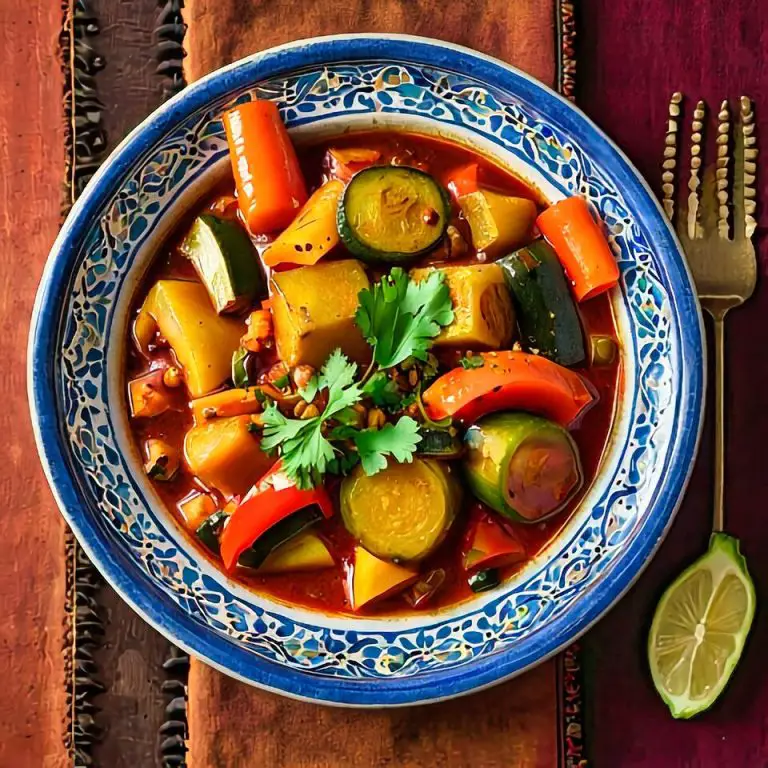
About Us
We are John and Laurel Rodgers, an American couple passionate about food and travel. Our journey takes us around the world, where we explore diverse cultures through their cuisine.
We collect recipes from local restaurants and take cooking classes wherever we go. Each recipe tells a story, connecting us with the people and traditions of the places we visit.
Our goal is to share these delicious dishes with our readers. We believe cooking brings people together, and we hope to inspire you to try new recipes at home.
To learn more about our adventures, visit our website at Boondocking Recipes. We also value wildlife preservation and support efforts in this area. You can read more about our commitment here.
Join us in our culinary journey as we discover and share the vibrant tastes of the world, starting with our Moroccan Vegetable Tagine recipe.
Why You’ll Love This Moroccan Vegetable Tagine Recipe
We appreciate this Moroccan Vegetable Tagine recipe for many reasons. First, it is a delicious and nutritious dish that features a colorful mix of vegetables. You’ll find carrots, potatoes, eggplant, and chickpeas, all simmered together in a flavorful broth.
This tagine is a one-pot meal, making it easy to prepare and clean up. We value meals that save us time in the kitchen without sacrificing taste.
Here’s what makes it stand out:
- Vegan and Plant-Based: This recipe is perfect for anyone looking for a vegan meal. It’s packed with nutrients from a variety of vegetables.
- Gluten-Free: Great for those with gluten sensitivities, providing tasty options without worrying about dietary restrictions.
- Healthy Meal: Loaded with vitamins and minerals, it’s a nutritious meal that promotes good health.
The spices used in this tagine offer a wonderful depth of flavor. They elevate the dish and create a warm, comforting experience.
Finally, it makes for a satisfying main course. We love serving it at family gatherings or enjoying it on chilly evenings. The warmth and comfort of this dish bring us all together.
What Makes This Recipe Special
We love the Moroccan Vegetable Tagine recipe for its vibrant flavors and ease of preparation. This dish is a staple of Moroccan cuisine, showcasing the rich culinary traditions of the region.
The use of aromatic spices sets it apart. We combine ingredients like cumin, coriander, and cinnamon, which create a warm and inviting aroma. These spices not only enhance flavor but also add nutritional benefits.
What makes this recipe truly special is its flexibility. We can use seasonal vegetables, allowing us to enjoy fresh produce year-round. This adaptability means the dish can be enjoyed in various forms, whether in a pot or a slow cooker.
The cooking method also contributes to its uniqueness. Slow cooking allows the flavors to meld beautifully, resulting in a rich, comforting meal. The vegetables become tender while retaining their essence.
Additionally, serving the dish with a drizzle of tahini sauce adds creaminess that complements the spices. The combination of textures and flavors makes every bite enjoyable.
For those new to Moroccan cooking, this is an easy Moroccan vegetable tagine recipe to start with. It invites exploration into the diverse tastes and ingredients of Moroccan culture, making it a delightful experience for anyone who tries it.
Cooking Equipment Needed
To make a delicious Moroccan Vegetable Tagine, we recommend using the right cooking equipment. Here’s what you will need:
- Tagine Pot: This is the traditional cooking vessel. It has a conical lid that helps retain moisture and flavor.
- Dutch Oven: If you don’t have a tagine pot, a Dutch oven works well. It can also hold heat evenly.
- Slow Cooker: For a more hands-off approach, a slow cooker is a great option. It allows the ingredients to meld together beautifully over time.
- Cutting Board: This is essential for prepping your vegetables.
- Chef’s Knife: A good knife is necessary for chopping vegetables cleanly.
- Wooden Spoon or Spatula: Use this for stirring ingredients while cooking.
- Measuring Cups and Spoons: These are important for measuring spices and liquid accurately.
When preparing your tagine, make sure to have your equipment organized. This will help you stay focused on making a fantastic dish. Enjoy the cooking process and the wonderful flavors of Moroccan cuisine!
Cooking Instructions
To make our Moroccan Vegetable Tagine, we will follow these simple steps.
- Prep the Vegetables: Chop onions, carrots, bell peppers, zucchini, potatoes, and eggplant into bite-sized pieces.
- Sauté the Aromatics: Heat extra virgin olive oil in a tagine or heavy pot. Add chopped onions and garlic, and cook until soft.
- Add Spices: Stir in spices like ground cumin, ground coriander, ground turmeric, and ground cinnamon. Let them cook for a minute to release their flavors.
- Combine Ingredients: Add in the chopped vegetables, chickpeas, and dried apricots. Mix in tomato paste and chopped tomatoes.
- Pour in Liquid: Add vegetable broth or vegetable stock until it covers the vegetables.
- Simmer: Cover and let it simmer on low heat for about 30-40 minutes. Stir occasionally until all vegetables are tender.
- Finish with Herbs: Before serving, mix in chopped fresh parsley and cilantro, and splash with lemon juice.
- Serve: Enjoy the tagine warm, garnished with additional herbs. You can serve it over couscous or with crusty bread.
This dish features a delightful mix of textures and flavors, perfect for any occasion.
Cooking Tips
To make the perfect Moroccan Vegetable Tagine, we recommend slow cooking. This method allows the flavors to blend beautifully.
Cooking at a low temperature for several hours enhances the taste and tenderness of the vegetables.
Here are some tips for better results:
- Use a Tagine: If you have one, a traditional tagine pot is ideal. Its shape helps circulate steam, keeping the dish moist.
- Saute First: Always sauté your onions and garlic before adding other ingredients. This builds a strong flavor base.
- Add Broth: Using chicken broth or vegetable broth instead of water adds more depth to the dish.
- Perfect Pairings: Serve your tagine hot with couscous, rice, or quinoa for a complete meal. These grains absorb the rich flavors.
- Try Flatbread: Moroccan flatbread is great for scooping up the tagine and adds a delicious texture.
- Leftovers: This dish is even better the next day. Store any leftovers in the fridge for up to three days.
- Side Dishes: Consider serving with a simple salad or roasted vegetables for added color and nutrition.
Ingredients For the Moroccan Vegetable Tagine Recipe
Spice Mix
Cardamom Powder
Coriander Powder
Cumin Powder
Fennel Powder
Cayenne
Turmeric
Cloves
Ginger
Tagine
Olive Oil
Onion
Garlic
Butternut Squash
Eggplant
Cauliflower
Bell Pepper
Tomatoes
Water
Salt
Black Pepper
Chickpeas
Green Beans
Lemon
Lemon Juice
Garnishes
Almonds
Coriander
Yogurt
Paprika
Cooking Instructions For the Moroccan Vegetable Tagine Recipe
Preparing the Tagine Spice Mix
Begin by combining all the ingredients for the Tagine Spice Mix and setting it aside. Preheat the oven to 180°C/350°F.
Sautéing the Aromatics and Vegetables
Heat 1 tablespoon of oil in a large, heavy-based pot over medium-high heat. Add the garlic and onion, cooking until the onion softens, which should take about 1 ½ minutes. Transfer them to a large bowl and scrape out any remaining garlic bits from the pan to prevent burning.
Add the pumpkin or squash to the pot and cook for about 3 minutes, stirring occasionally, until it develops a light golden color on most sides. Transfer it to the same bowl. Pour in 2 tablespoons of olive oil and add the eggplant, cooking for another 3 minutes until it becomes tinged with gold, then remove it to the bowl.
If the pot appears dry, add 1 more tablespoon of oil before adding the capsicum and cauliflower. Cook for 2 minutes, allowing the cauliflower to develop a slight golden edge. Transfer them to the bowl with the other vegetables.
Cooking the Tagine
Add the tomatoes to the pot and cook for 1 minute before stirring in the Spice Mix. Let the spices cook for another minute to bring out their flavors. Return all the vegetables to the pot, then pour in enough water to just about cover them. Season with salt and pepper, then stir to combine. Bring the mixture to a simmer on the stove, then transfer the pot to the oven and bake for 30 minutes. Alternatively, you can let it simmer on low heat on the stove, but stir gently to prevent the vegetables from breaking down too much.
Final Touches and Serving
After 30 minutes, remove the pot from the oven and add the beans and chickpeas. Let the mixture simmer uncovered on medium-low heat for 15 minutes to allow the beans to cook and the sauce to reduce. Stir in the lemon juice and zest. Some of the vegetables, such as butternut squash and cauliflower, will naturally break down slightly, helping to thicken the sauce. The texture will continue to improve if left overnight.
For a traditional experience, serve over couscous. Alternatively, try white, brown, or basmati rice, or even quinoa. It can also be enjoyed on its own as a hearty stew. For a low-carb option, serve with cauliflower rice. Garnish with a dollop of yogurt, a sprinkle of almonds, fresh coriander or cilantro, and a touch of paprika or cayenne for added flavor.
FAQ For the Moroccan Vegetable Tagine Recipe
Question: What ingredients are typically used in a Moroccan Vegetable Tagine recipe?
A: A Moroccan Vegetable Tagine recipe usually includes carrots, zucchini, bell peppers, tomatoes, chickpeas, onions, garlic, and a blend of spices such as cumin, coriander, paprika, turmeric, and cinnamon.
Question: How do you cook a Moroccan Vegetable Tagine recipe without a traditional tagine pot?
A: A Moroccan Vegetable Tagine recipe can be cooked in a heavy-bottomed pot or Dutch oven by slowly simmering the vegetables and spices over low heat, ensuring the flavors blend well.
Question: Can I make a Moroccan Vegetable Tagine recipe ahead of time?
A: Yes, a Moroccan Vegetable Tagine recipe can be made in advance as the flavors develop even more when allowed to sit. It can be stored in the refrigerator for up to three days and reheated before serving.
Question: What can I serve with a Moroccan Vegetable Tagine recipe?
A: A Moroccan Vegetable Tagine recipe is commonly served with couscous, rice, or crusty bread to soak up the flavorful sauce.
Question: Is a Moroccan Vegetable Tagine recipe suitable for vegans?
A: Yes, a Moroccan Vegetable Tagine recipe is naturally vegan as it consists of vegetables, spices, and plant-based ingredients without any animal products.
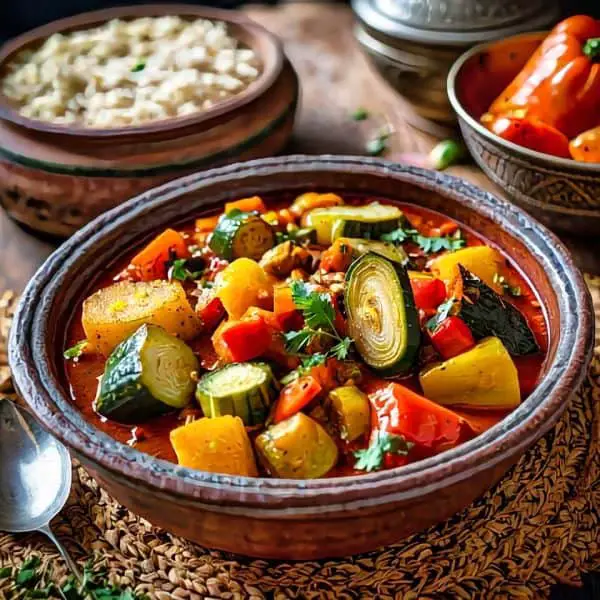
Moroccan Vegetable Tagine Recipe
Ingredients
Tagine spice mix:
- 1 tbsp cardamom powder
- 1 tbsp coriander powder
- 1 tbsp cumin powder
- 1 1/2 tsp fennel powder
- 1 tsp cayenne
- 2 tsp turmeric
- 1/4 tsp ground cloves
- 1/4 tsp ground ginger
Tagine
- 5 tbsp olive oil
- 1/2 red onion sliced
- 1 garlic clove finely minced
- 1.6 lb butternut pumpkin 1" cubes
- 1 eggplant 1/2″ cubes
- 1/2 cauliflower small, cut into bite size florets
- 1 bell pepper cut into 1" pieces
- 2 tomatoes seeds removed, cut into 1cm / 1/3″ dice
- 3 1/2 cups water
- 2 tsp salt
- 1/2 tsp black pepper
- 14 oz canned chickpeas drained
- 60 oz green beans
- 1 lemon Zest of
- 2 tbsp lemon juice
Garnishes
- 1/2 cup Almonds toastedslivered
- 1/4 cup coriander / cilantro roughly chopped
- Yogurt
- Pinch of paprika or cayenne pepper
Instructions
Preparing the Tagine Spice Mix
- Begin by combining all the ingredients for the Tagine Spice Mix and setting it aside. Preheat the oven to 180°C/350°F.
Sautéing the Aromatics and Vegetables
- Heat 1 tablespoon of oil in a large, heavy-based pot over medium-high heat. Add the garlic and onion, cooking until the onion softens, which should take about 1 ½ minutes. Transfer them to a large bowl and scrape out any remaining garlic bits from the pan to prevent burning.
- Add the pumpkin or squash to the pot and cook for about 3 minutes, stirring occasionally, until it develops a light golden color on most sides. Transfer it to the same bowl. Pour in 2 tablespoons of olive oil and add the eggplant, cooking for another 3 minutes until it becomes tinged with gold, then remove it to the bowl.
- If the pot appears dry, add 1 more tablespoon of oil before adding the capsicum and cauliflower. Cook for 2 minutes, allowing the cauliflower to develop a slight golden edge. Transfer them to the bowl with the other vegetables.
Cooking the Tagine
- Add the tomatoes to the pot and cook for 1 minute before stirring in the Spice Mix. Let the spices cook for another minute to bring out their flavors. Return all the vegetables to the pot, then pour in enough water to just about cover them. Season with salt and pepper, then stir to combine. Bring the mixture to a simmer on the stove, then transfer the pot to the oven and bake for 30 minutes. Alternatively, you can let it simmer on low heat on the stove, but stir gently to prevent the vegetables from breaking down too much.
Final Touches and Serving
- After 30 minutes, remove the pot from the oven and add the beans and chickpeas. Let the mixture simmer uncovered on medium-low heat for 15 minutes to allow the beans to cook and the sauce to reduce. Stir in the lemon juice and zest. Some of the vegetables, such as butternut squash and cauliflower, will naturally break down slightly, helping to thicken the sauce. The texture will continue to improve if left overnight.
- For a traditional experience, serve over couscous. Alternatively, try white, brown, or basmati rice, or even quinoa. It can also be enjoyed on its own as a hearty stew. For a low-carb option, serve with cauliflower rice. Garnish with a dollop of yogurt, a sprinkle of almonds, fresh coriander or cilantro, and a touch of paprika or cayenne for added flavor.

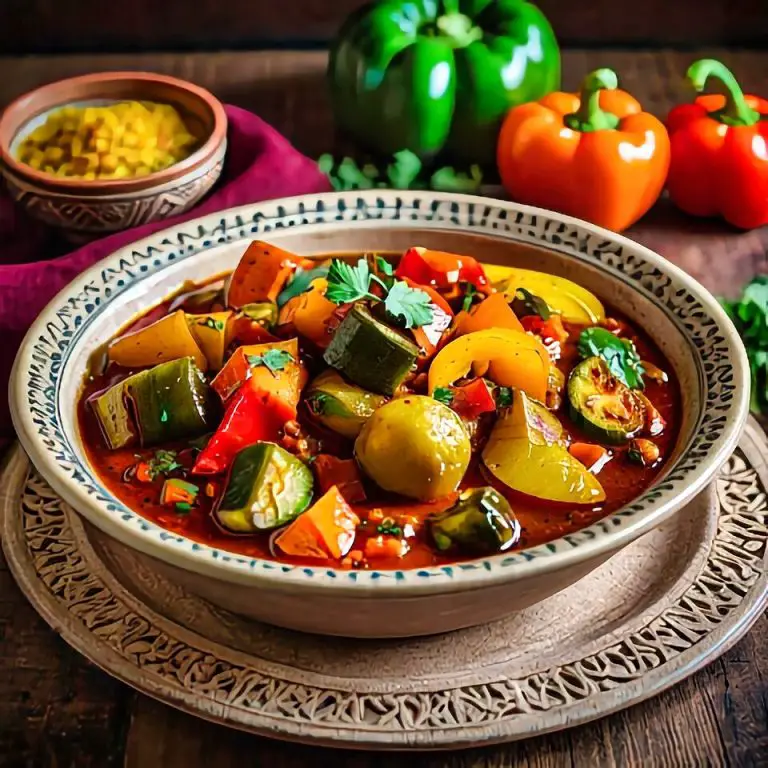
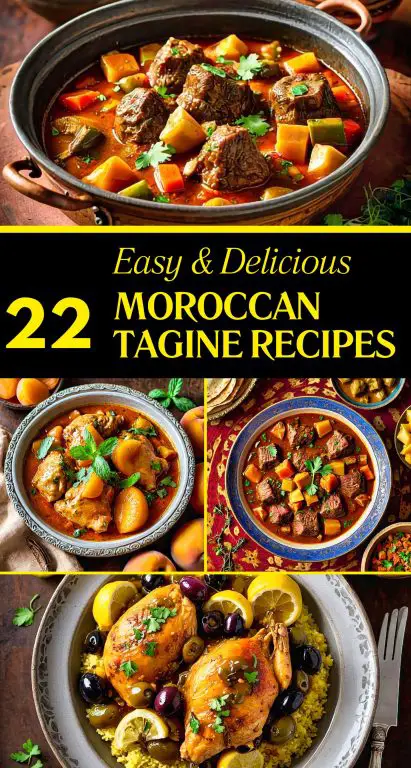
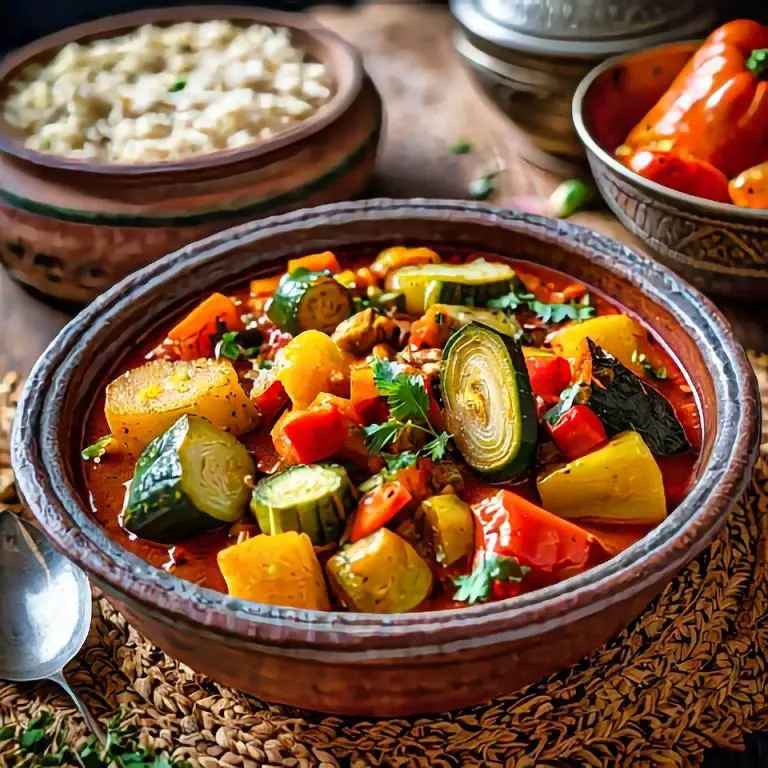
3 comments
This dish was a beautiful mix of textures and bold, spiced flavours! The vegetables softened to perfection, and the sauce coated everything in a fragrant, warming blend of spices. Served it with fresh bread to scoop up every bit, and my guests kept saying how satisfying and full of flavour it was. A great meat-free option that I’ll be making again!
Im not convinced about the necessity of all those cooking equipment listed. Cant we just make this tagine recipe with what we already have in our kitchen? Seems a bit excessive to me.
Im not convinced that the cooking equipment listed is really necessary for this Moroccan Vegetable Tagine recipe. Seems a bit excessive, dont you think? I mean, who needs all that fancy stuff to make a delicious dish?